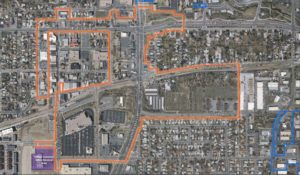
City streets and commercial centers have a common lifecycle. There is the initial build followed by a vibrant life and eventual decline. The question is how does a city address an area in decline and return it to a place that meets current and ongoing needs?
This is where Arvada Urban Renewal Authority steps in. AURA breathes new life into fading pockets of Arvada. AURA’s actions are guided by meticulous steps and requirements set forth by Colorado law – complete with checks and balances.
AURA can’t go into any random corner of Arvada and begin working. AURA’s work is limited to the specific boundaries of urban renewal areas.
Recommendations for new urban renewal areas come from a variety of sources, including the City Council, the City’s Community Development Department, and residents. All urban renewal districts are required to focus on areas marked by deterioration and safety concerns – referred to as “blight” in the realm of urban renewal.
Once an area is identified as blighted, AURA coordinates with the City and hires a third-party expert to complete a blight study. This in-depth analysis serves as a detective’s toolkit, uncovering signs of decay, infrastructure issues, and threats to public safety. To be deemed eligible the area must satisfy a legal litmus test and meet a minimum of four out of 11 factors outlined by Colorado law.
AURA also seeks input from Arvadans. AURA holds public hearings and asks for feedback from property owners and local businesses to better understand the needs and goals of the community. If blight is present, AURA springs into action with the creation of a comprehensive urban renewal plan.
AURA can’t levy or increase taxes. Instead, urban renewal districts rely on Tax Increment Financing (TIF) to help reshape a deteriorating area. Blighted areas don’t generally create a lot of tax revenue, but once cleaned and redeveloped, these areas may create new sales or property tax streams. The new revenue is the TIF that AURA can use to fund projects focused on remediating blight.
Once approved by AURA’s board the urban renewal plan is presented to the Planning Commission and City Council. The City Council has the final vote before an urban renewal plan is adopted.
Often, individuals argue that urban renewal areas should be left for private sector development to solve the problem. An urban renewal area has needs that are bigger than what the market can typically solve without assistance. Instead, AURA partners with private development to reshape areas that need a little TLC.